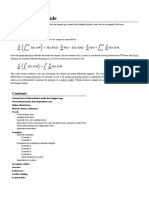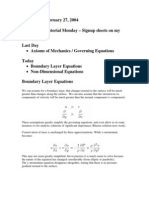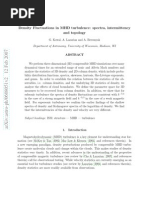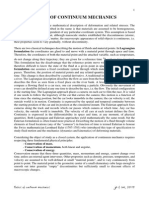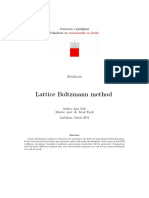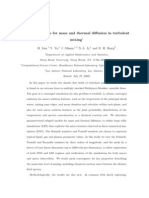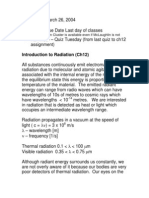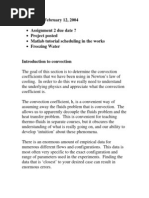100%(1)100% found this document useful (1 vote)
859 viewsAverage Convection Coefficient Example - Start of Blasius Solution For Flow Over A Flat Plate
Average Convection Coefficient Example - Start of Blasius Solution For Flow Over A Flat Plate
Uploaded by
msnaghavi- The document discusses a boundary layer example of laminar flow over a flat plate.
- Initially the boundary layer is laminar, then transitions to turbulence at a critical Reynolds number. When turbulent, the boundary layer becomes unsteady and heat/mass transfer increases.
- The document begins deriving the Blasius solution for laminar flow over a flat plate using equations for conservation of mass, momentum, and energy, and introducing variables like the stream function to simplify the equations.
Copyright:
Attribution Non-Commercial (BY-NC)
Available Formats
Download as PDF or read online from Scribd
Average Convection Coefficient Example - Start of Blasius Solution For Flow Over A Flat Plate
Average Convection Coefficient Example - Start of Blasius Solution For Flow Over A Flat Plate
Uploaded by
msnaghavi100%(1)100% found this document useful (1 vote)
859 views5 pages- The document discusses a boundary layer example of laminar flow over a flat plate.
- Initially the boundary layer is laminar, then transitions to turbulence at a critical Reynolds number. When turbulent, the boundary layer becomes unsteady and heat/mass transfer increases.
- The document begins deriving the Blasius solution for laminar flow over a flat plate using equations for conservation of mass, momentum, and energy, and introducing variables like the stream function to simplify the equations.
Original Title
• Average convection coefficient example • Start of Blasius Solution for flow over a flat plate
Copyright
© Attribution Non-Commercial (BY-NC)
Available Formats
PDF or read online from Scribd
Share this document
Did you find this document useful?
Is this content inappropriate?
- The document discusses a boundary layer example of laminar flow over a flat plate.
- Initially the boundary layer is laminar, then transitions to turbulence at a critical Reynolds number. When turbulent, the boundary layer becomes unsteady and heat/mass transfer increases.
- The document begins deriving the Blasius solution for laminar flow over a flat plate using equations for conservation of mass, momentum, and energy, and introducing variables like the stream function to simplify the equations.
Copyright:
Attribution Non-Commercial (BY-NC)
Available Formats
Download as PDF or read online from Scribd
Download as pdf
100%(1)100% found this document useful (1 vote)
859 views5 pagesAverage Convection Coefficient Example - Start of Blasius Solution For Flow Over A Flat Plate
Average Convection Coefficient Example - Start of Blasius Solution For Flow Over A Flat Plate
Uploaded by
msnaghavi- The document discusses a boundary layer example of laminar flow over a flat plate.
- Initially the boundary layer is laminar, then transitions to turbulence at a critical Reynolds number. When turbulent, the boundary layer becomes unsteady and heat/mass transfer increases.
- The document begins deriving the Blasius solution for laminar flow over a flat plate using equations for conservation of mass, momentum, and energy, and introducing variables like the stream function to simplify the equations.
Copyright:
Attribution Non-Commercial (BY-NC)
Available Formats
Download as PDF or read online from Scribd
Download as pdf
You are on page 1of 5
Lecture 22, March 1, 2004
• Matlab Tutorial Today (3:30-4:30) (4:30-5:30)
• Assignment 3 (will be posted today, due end of next
week?)
• Quiz 2 (covers material after quiz1 to the end of
this week)
Today
• Average convection coefficient example
• Start of Blasius Solution for flow over a flat plate
Boundary Layer Example
Initially, the boundary layer on a flat plate will be laminar,
and will transition to turbulence at some critical Reynolds
number Rex,c. When the boundary layer becomes turbulent,
it will of course become unsteady, and heat and mass
transfer will be increased. Therefore we will consider the
time average turbulent quantities.
In reality this transition is not abrupt, but occurs over a
transition region. We must fix a value of either Rex,c, or of
xc in order to obtain a solution.
Let’s start be examining some velocity profiles in the
laminar portion of our plate, for air at 3 m/s. For these
conditions xc corresponds to 3m, and so we will have a
laminar boundary layer for the first 3m.
Clearly, the gradient of the velocity profile at the wall is
decreasing with distance along the plate, and we therefore
expect that the rate of heat transfer will decrease along the
plate as well. Clearly, the highest heat transfer coefficient
will exist at the leading edge of the plate.
The rest of this example is posted separately.
Blasius Solution for Laminar flow over a plat plate.
Beginning with our equation for conservation of mass (2D
Steady, constant properties),
And conservation of momentum in the x direction (with the
boundary layer assumptions) and with zero pressure
gradient as in the case of a flat plate
And, the boundary layer energy equation
In order to simplify these equations, we introduce the
stream function
Substituting these definitions into mass conservation,
We see that it is identically satisfied and we need not
consider mass conservation any further as long as we use
the stream function.
Next we want to simplify the momentum equation. We do
this by postulating that there is some scaling parameter that
will collapse all of the velocity profiles onto a single curve.
This is a similarity parameter, and hence the solution is
called a similarity solution. When we find this parameter,
our two dimensional problem will be reduced to a one
dimensional problem and will be much easier to solve.
This parameter has been found, and is in fact the way the
profiles develop (you can measure this).
Next, we want to define a non-dimensional stream function
using our similarity parameter.
All we need to do is evaluate all of the terms in the
momentum equation in terms of f and η, and then we will
have our simplified ordinary differential equation (one
dimensional).
Beginning with u,
or,
And, more involved is v,
Finally, our three derivative terms,
We can now substitute all of these into the momentum
equation to get,
or, in simplified notation,
You might also like
- Development of A Solver For The Heat Equation Using MATLABDocument14 pagesDevelopment of A Solver For The Heat Equation Using MATLABManan Academy100% (2)
- Flow Over A Backward Facing Step: TMMV08 Assignment 3Document9 pagesFlow Over A Backward Facing Step: TMMV08 Assignment 3Arturo Mateos RodríguezNo ratings yet
- Advancements in Solving Ballistic Equations Involving Quadratic DragDocument21 pagesAdvancements in Solving Ballistic Equations Involving Quadratic DragElliott WallNo ratings yet
- Boundary Element and Finite Element MethodsDocument73 pagesBoundary Element and Finite Element MethodsticoncoolzNo ratings yet
- Leibniz Integral RuleDocument14 pagesLeibniz Integral RuleDaniel GregorioNo ratings yet
- Sheet of Modern Physics Student Copy With Ans 02-09-2021 1631011715226Document35 pagesSheet of Modern Physics Student Copy With Ans 02-09-2021 1631011715226Mohit KumarNo ratings yet
- Boundary Layer Equations - Non-Dimensional EquationsDocument8 pagesBoundary Layer Equations - Non-Dimensional Equationsmsnaghavi100% (1)
- High Speed Aerodynamics Prof. K. P. Sinhamahapatra Department of Aerospace Engineering Indian Institute of Technology, KharagpurDocument15 pagesHigh Speed Aerodynamics Prof. K. P. Sinhamahapatra Department of Aerospace Engineering Indian Institute of Technology, KharagpurRitu SinghNo ratings yet
- Lec34 PDFDocument15 pagesLec34 PDFRitu SinghNo ratings yet
- StokesFlowSimulation TutorialDocument20 pagesStokesFlowSimulation TutorialHridey GuptaNo ratings yet
- Thermal Boundary Layer SolutionDocument6 pagesThermal Boundary Layer Solutionmsnaghavi100% (3)
- OijadinDocument29 pagesOijadinbbot909No ratings yet
- Turbulence ScalesDocument34 pagesTurbulence ScalesAhmed Valentin KassemNo ratings yet
- Introduction To Finite Element AnalysisDocument20 pagesIntroduction To Finite Element AnalysisVishnu Vardhan Reddy GangapuramNo ratings yet
- Computational Techniques Prof. Dr. Niket Kaisare Department of Chemical Engineering Indian Institute of Technology, MadrasDocument30 pagesComputational Techniques Prof. Dr. Niket Kaisare Department of Chemical Engineering Indian Institute of Technology, MadrasjagaenatorNo ratings yet
- Ondas DinâmicasDocument16 pagesOndas DinâmicasivyjeannNo ratings yet
- Chapter5 Forced ConvectionDocument28 pagesChapter5 Forced Convectionنهاد نهادNo ratings yet
- Chapitre 2 PDFDocument17 pagesChapitre 2 PDFMouhaNo ratings yet
- H. Lim Et Al - Subgrid Models in Turbulent MixingDocument5 pagesH. Lim Et Al - Subgrid Models in Turbulent MixingMfdrrNo ratings yet
- Boundary Value Problems: Selected ReadingDocument35 pagesBoundary Value Problems: Selected ReadingP KNo ratings yet
- Time-Averaged Governing Equations For TurbulenceDocument9 pagesTime-Averaged Governing Equations For TurbulenceMinu.j.jNo ratings yet
- Quasi-Stationary Stefan Problem and Computer Simulation of Interface DynamicsDocument22 pagesQuasi-Stationary Stefan Problem and Computer Simulation of Interface DynamicsvagafNo ratings yet
- TMMV08 A1 2024Document9 pagesTMMV08 A1 2024adityaNo ratings yet
- Finite Element Analysis Prof. Dr.B.N.Rao Department of Civil Engineering Indian Institute of Technology, MadrasDocument42 pagesFinite Element Analysis Prof. Dr.B.N.Rao Department of Civil Engineering Indian Institute of Technology, MadrasfefahimNo ratings yet
- MITOCW - MITRES2 - 002s10nonlinear - Lec12 - 300k-mp4: NarratorDocument16 pagesMITOCW - MITRES2 - 002s10nonlinear - Lec12 - 300k-mp4: NarratorBastian DewiNo ratings yet
- PCFD 05Document8 pagesPCFD 05Saher SaherNo ratings yet
- FDM, Fem, FVMDocument32 pagesFDM, Fem, FVMRaj EaswarmoorthiNo ratings yet
- Overall Framework: Balance EquationsDocument11 pagesOverall Framework: Balance EquationsRhazy la BestiaNo ratings yet
- Method o LogieDocument11 pagesMethod o Logielouis gauvainNo ratings yet
- UNIT NO 1: Finite Difference SchemesDocument9 pagesUNIT NO 1: Finite Difference SchemesAbhishek SaxenaNo ratings yet
- A Second-Order Godunov Method On Arbitrary GridsDocument13 pagesA Second-Order Godunov Method On Arbitrary Gridsomidutd_99No ratings yet
- Poiseuille-EPJ Plus-Publié PDFDocument27 pagesPoiseuille-EPJ Plus-Publié PDFmartine.le-berreNo ratings yet
- G. Kowal, A. Lazarian and A. Beresnyak - Density Fluctuations in MHD Turbulence: Spectra, Intermittency and TopologyDocument55 pagesG. Kowal, A. Lazarian and A. Beresnyak - Density Fluctuations in MHD Turbulence: Spectra, Intermittency and TopologyWhiteLighteNo ratings yet
- Linear AdvectionDocument21 pagesLinear AdvectionKenneth DavisNo ratings yet
- Résumé BiblioDocument10 pagesRésumé Bibliolouis gauvainNo ratings yet
- Losing Forward Momentum Holographically: YITP-SB-13-44Document42 pagesLosing Forward Momentum Holographically: YITP-SB-13-44crocoaliNo ratings yet
- Nuclear Astrophysics: Shawn - Bishop@ph - Tum.deDocument42 pagesNuclear Astrophysics: Shawn - Bishop@ph - Tum.deJ Jesús Villanueva GarcíaNo ratings yet
- Marine HydrodynamicsDocument22 pagesMarine HydrodynamicsJaume TriayNo ratings yet
- Data On The Velocity Slip and Temperature Jump CoefficientsDocument7 pagesData On The Velocity Slip and Temperature Jump CoefficientsDiaul VikriNo ratings yet
- Time-Dependent Boundary Conditions For Hyperbolic Systems, IIDocument23 pagesTime-Dependent Boundary Conditions For Hyperbolic Systems, IIprashant_salima6377No ratings yet
- Class EmfDocument31 pagesClass EmfMarko CetrovivcNo ratings yet
- Continuum MechancsDocument20 pagesContinuum MechancsMahmoud HefnyNo ratings yet
- Chapter 2Document10 pagesChapter 2abdul azizNo ratings yet
- The Motion of A Surface by Its Mean Curvature Kenneth A. Brakke All Chapters Instant DownloadDocument70 pagesThe Motion of A Surface by Its Mean Curvature Kenneth A. Brakke All Chapters Instant Downloadzhaskcsegei100% (10)
- Shear Flow: 3.1 Transport Processes and Transport CoefficientsDocument15 pagesShear Flow: 3.1 Transport Processes and Transport CoefficientsRadha Krishnan RNo ratings yet
- Lec34 PDFDocument27 pagesLec34 PDFAjit ParwaniNo ratings yet
- Kin ENGDocument25 pagesKin ENGLakshyaNo ratings yet
- Taylor's Theorem and Its ApplicationsDocument20 pagesTaylor's Theorem and Its ApplicationseracksNo ratings yet
- Gord Is 1979Document12 pagesGord Is 1979NixonNo ratings yet
- Lattice Boltzmann MethodDocument15 pagesLattice Boltzmann MethodsvkindiaNo ratings yet
- Equations of MotionDocument13 pagesEquations of MotionD-Cristen OrlandoNo ratings yet
- Chap 6 Numhyd Riemann 1Document13 pagesChap 6 Numhyd Riemann 1rickyspaceguyNo ratings yet
- Lec5 PDFDocument40 pagesLec5 PDFEliNo ratings yet
- Homework 5Document3 pagesHomework 5vassaNo ratings yet
- Where Are We Now?: F L Q LDocument20 pagesWhere Are We Now?: F L Q LgornetjNo ratings yet
- H. Lim Et Al - Subgrid Models For Mass and Thermal Diffusion in Turbulent MixingDocument39 pagesH. Lim Et Al - Subgrid Models For Mass and Thermal Diffusion in Turbulent MixingMfdrrNo ratings yet
- Air Bearing CalculationDocument47 pagesAir Bearing CalculationtomekzawistowskiNo ratings yet
- Understanding Vector Calculus: Practical Development and Solved ProblemsFrom EverandUnderstanding Vector Calculus: Practical Development and Solved ProblemsNo ratings yet
- Termodinamika Vol 1Document138 pagesTermodinamika Vol 1Moh Rusli BahtiarNo ratings yet
- Energy Use in The Transportation Sector of MalaysiaDocument306 pagesEnergy Use in The Transportation Sector of Malaysiamsnaghavi100% (14)
- Energy Demand and Emissions From Transportation Sector in MalaysiaDocument22 pagesEnergy Demand and Emissions From Transportation Sector in Malaysiamsnaghavi100% (3)
- Energy Use in The Transportation Sector of MalaysiaDocument306 pagesEnergy Use in The Transportation Sector of Malaysiamsnaghavi100% (14)
- Two Phase Flow Phase Change and Numerical ModelingDocument596 pagesTwo Phase Flow Phase Change and Numerical Modelingmsnaghavi100% (2)
- Summary Heat TransferDocument4 pagesSummary Heat TransferPRASAD326No ratings yet
- Introduction To Radiation (Ch12) : O Jackson Cluster Is Available Even If Mclaughlin Is NotDocument4 pagesIntroduction To Radiation (Ch12) : O Jackson Cluster Is Available Even If Mclaughlin Is Notmsnaghavi100% (1)
- Natural Convection ContdDocument5 pagesNatural Convection ContdmsnaghaviNo ratings yet
- Convection in Internal FlowsDocument7 pagesConvection in Internal Flowsmsnaghavi100% (1)
- Mech 346: Heat Transfer: What You Dare To Dream ..Document12 pagesMech 346: Heat Transfer: What You Dare To Dream ..msnaghaviNo ratings yet
- Introduction To ConvectionDocument4 pagesIntroduction To ConvectionmsnaghaviNo ratings yet
- CFD (Computional Fluid Dynamics) QuizDocument18 pagesCFD (Computional Fluid Dynamics) Quizmsnaghavi100% (1)
- DLL Cot 2Document6 pagesDLL Cot 2ROVELAINE ANDALLONNo ratings yet
- 11.3b SoundDocument3 pages11.3b SoundWeteachNo ratings yet
- GP 1 Group 5Document11 pagesGP 1 Group 5ランベイ リチャードNo ratings yet
- Pure Rolling ContactDocument29 pagesPure Rolling ContactNiaz KilamNo ratings yet
- Experiments in Engineering Physics: Sem Ii (Document43 pagesExperiments in Engineering Physics: Sem Ii (SiddhinathNo ratings yet
- 13 ColorTemperatureDocument5 pages13 ColorTemperatureNayan MallickNo ratings yet
- D Gloge Applied OpticsDocument7 pagesD Gloge Applied Opticsjai singhNo ratings yet
- (Rohde - Schwarz) 5G - MassiveMIMO - BS - TestingDocument4 pages(Rohde - Schwarz) 5G - MassiveMIMO - BS - TestinghongthangnvNo ratings yet
- Correlations ComparisonDocument12 pagesCorrelations ComparisonmattiturboNo ratings yet
- Architectural AcousticDocument33 pagesArchitectural AcousticSampada Mgr100% (1)
- Astec Faq PDFDocument12 pagesAstec Faq PDFAnonymous 1GK9Hxp5YKNo ratings yet
- PhysicsDocument25 pagesPhysicsCaitlyn WidiantoNo ratings yet
- 02 - Physics Module Chapter 2.1Document9 pages02 - Physics Module Chapter 2.1ZazaNo ratings yet
- Propagation and Attenuation Characteristics of Various Ground VibrationsDocument12 pagesPropagation and Attenuation Characteristics of Various Ground VibrationsTony Christian Canahua ChoquezaNo ratings yet
- Angle Beam Shear Wave NDTDocument5 pagesAngle Beam Shear Wave NDTPDDELUCANo ratings yet
- Refraction and ReflectionDocument7 pagesRefraction and ReflectionAndrew EdwardsNo ratings yet
- Numerical Analysis of A Hypersonic Turbulent and LDocument13 pagesNumerical Analysis of A Hypersonic Turbulent and LDANUSH DATTHATHIREYAN KNo ratings yet
- Climate and Weather SummariesDocument52 pagesClimate and Weather SummariesEskay DevandalNo ratings yet
- Contrast Medium Experiment With A Blood Vessel ModelDocument3 pagesContrast Medium Experiment With A Blood Vessel ModelJose GalvanNo ratings yet
- Lecture 2 Curvilinear MotionDocument87 pagesLecture 2 Curvilinear MotionDave CruzNo ratings yet
- Chapter No 1Document26 pagesChapter No 1Moin Khan100% (2)
- Solution To Tut 3 PDFDocument11 pagesSolution To Tut 3 PDFkalirajgurusamyNo ratings yet
- Velocity MethodDocument27 pagesVelocity Methodkurdishsillyboy2004No ratings yet
- Article AntHist 81Document12 pagesArticle AntHist 81Marjan BlagojevicNo ratings yet
- Quantum Mechanics NotesDocument23 pagesQuantum Mechanics Notesnaman shahNo ratings yet
- Concentric Tube Heat ExchangerDocument19 pagesConcentric Tube Heat ExchangerAnisAsyiqinNo ratings yet
- Solar Energy - Jatnika Setiawan - NIM 23123004Document2 pagesSolar Energy - Jatnika Setiawan - NIM 23123004Jatnika SetiawanNo ratings yet
- 01a ModulationDocument26 pages01a Modulation2022-102519No ratings yet
- Practical Algorithms For Simulation and Reconstruction of Digital In-Line HologramsDocument28 pagesPractical Algorithms For Simulation and Reconstruction of Digital In-Line HologramsOlgert MagilajNo ratings yet




